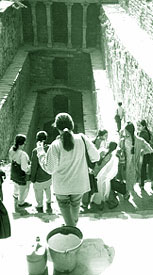 |
Students exploring Gandhak Baoli
at Mehrauli, New Delhi |
The Environmental Education Unit at CSE, New
Delhi aims to stimulate young minds to question prevailing development patterns,
lifestyles and governance system. The goal is to widen the perspective of students in the
age group 10-15 years towards the city’s environment and to make them understand the
symbiotic relationship between a city and its inhabitants.
Big cities like Delhi try to meet the rising
demand of water by procuring water from distant sources like Tehri dam, often depriving
the poor people of these regions. Our country has already spent Rs. 70,000 crore since
Independence on developing water works with Rs. 10,556 crores alone on big dams. And yet,
severe water shortage continues to affect thousands of villages and urban centres.
The unit therefore organised a tour for students
from various schools in Delhi to emphasise the importance and relevance of ‘catching
rainwater’ to overcome water shortage. The students were taken to Hauz-e-Shamsi and
Jharna, two traditional water harvesting structures, to show them how
such structures can deal with water shortage. The students were also taken to Tughlaqabad
fort and the 1000 year old Anangpur dam.
The tour motivated teachers and students alike.
Mrs. Usha Srinivasan, Principal of the Sanskriti school who had accompanied her students
on the tour has now initiated water harvesting in the school. School students residing in
Malviya Nagar have shown keen interest in learning water harvesting techniques.
People from other walks of life have also shown
interest. The Greater Kailash Residents Association has expressed interest in knowing more
about water harvesting. The Gujarat Nature Conservation Society has also asked for ideas
on water management. We hope more and more people become aware and interested in water
harvesting schemes in the near future. The CSE is gearing up to offer water harvesting
services.


Indian states for water policy
Water Policy
in UP
Uttar Pradesh cabinet, following Andhra Pradesh, has approved a water policy that devolves
powers from the irrigation officials to the village panchayat through Water Users body.
The Kalyan Singh cabinet has approved the new water policy of the state keeping in mind
the growing demand of potable, drinking and irrigation water in the next century, as the
population of the state would be touching 27 crores in 2025 A.D. The thrust of this
devolution policy is that the Water Users body will be responsible for the water
management and adequate drinking water supply, proper irrigation facility, hydro-electric
power generation and support to the agriculture and allied industries, and water
transport.
It is proposed that through the Water Users, which will be a registered body under the
village panchayat, are expected to promote equitable and opitmal utilisation of water. The
executive engineer of the Irrigation Department will sign a Memorandum of Understanding
(MoU) with these user groups, and work as an implementing agency for the policies
formulated by the State Government. The policy aims at modernisation and updation of
channels and modern conveyance management.
Himachal Pradesh to harvest
rain
Burried beneath the new houses and gardens of Jakhu hill, the
highest point in Shimla, are many snow pits that people used a century ago to collect
water. But today, despite receiving 1134 millimetres (mm) of average rainfall every year,
Himachal Pradesh faces acute water shortage in almost all the 59 urban settlements in the
state, especially during the summer months. With most residents living on hilltops, the
water collected downhill is supplied to the people through lift schemes. In order to
rationalise the collection and distribution systems, the state cabinet has now decided to
make rainwater harvesting mandatory for all new constructions and the existing public
buildings in the state. Close on the heels of similar directives in the Chennai
metropolitan city, Himachal Pradesh, directed all commercial and institutional buildings
of over 1000 square metre plinth area to have rainwater storage facilities.